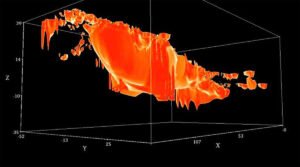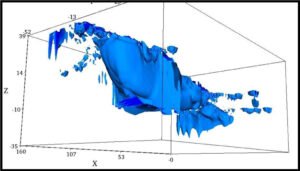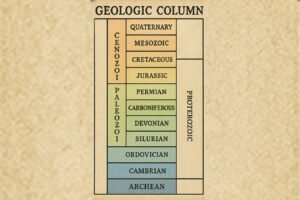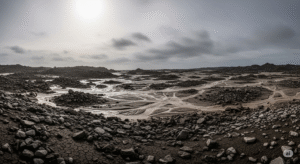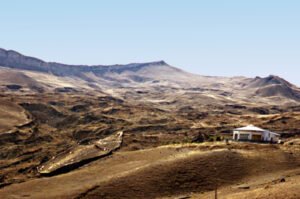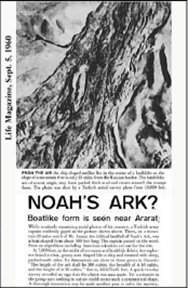1988 Still More to Come
The Documentary- Noah's Ark Found
The dedication of Noah's Ark took place in June of 1987. After that, Ron worked with a production crew making a documentary of all the work that led up to that exciting conclusion. "Noah's Ark Found" was finished in early 1988 and Ron was not real happy with it. He told me they were too afraid to come right out and shout the discovery to the world like he wanted to.
April 1988- A Chance Meeting
April of 1988, a salesman in the brokerage firm where I worked told me that he knew the man who had discovered Noah's Ark. I had only recently renewed my faith in the Biblical account and become a dedicated believer. Even so, I met his statement with, "Sure you do". But he insisted that it was true. This co-worker had heard him speak at a Lion's Club meeting in Nashville.
I asked him to call this man and see if he had any books. He didn't. I had lived in Nashville since 1977 but I didn't recall hearing about this man. To make a long story short, in a few weeks, Ron came to my office after my colleague had told him that he had some co-workers who were interested in hearing about his discovery of Noah's Ark.
Ron spent a couple of hours telling us about the ark and some of his other discoveries, but the thing that stood out in my mind was that I had never heard anyone speak so openly about Jesus Christ as he did. With only a couple of photographs (small ones at that) I was convinced he was telling the truth.
How Do I Get to Noah's Ark?
After he left, I decided that evening I was going to spend my summer vacation visiting Noah's Ark. Ron had told us it was official and about the visitors' center, so I began to call travel agents, only to discover that their reaction was about like mine when colleague told me he knew the man who found Noah's Ark. So, about a week later, I had my colleague call "Mr. Wyatt" for me and get directions to the ark. I sat with him as he began writing down strange foreign names of cities and my co-worker got frustrated and said to Ron, "Here, you talk to her" and handed me the phone.
When I got on the phone, Ron was surprised to learn that the person wanting to go was a female, and he told me under no circumstances could I go there by myself. I was crushed. I had a video camera and had planned to video the ark to use as a means to prove the validity of the Bible to others. But he hesitantly told me that if I could afford it, if I could take directions and stay out of the way, he guessed I could go with his next expedition which would go the next month on May 30.
I was shocked and thrilled. I was able to quickly make the arrangements. But never did I suspect how my life was about to change. We were married July 5, 1988 and I would work with him closely until his death.
June 1988- Noah's Ark
Dr. Nathan Meyer accompanied us and the other team members had cancelled out at the last minute. When we arrived at the ark, Hasan Ozer, the villager from Uzengili, which is right above the ark, met us at the bus and showed us the new visitors' center which was still under construction.
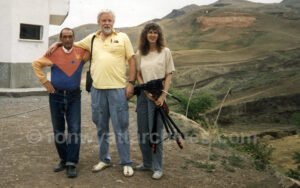
Ron Gives Nathan and Mary Nell a Tour of the Ark
The ark in person is incredibly breathtaking. As we walked down to it and got closer, the indentions where the rib timbers were deteriorating away and leaving voids were extremely visible. He explained that most likely, Noah and his family had removed the outer part of the ship to use for building material since there were no trees for quite a long time.
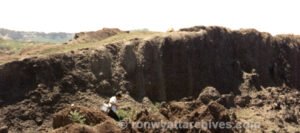
Ron walked the entire site with us, explaining every feature. He showed us the deck joists that extended out from the interior sides where the decks had collapsed.
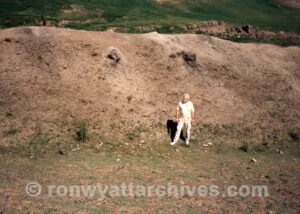
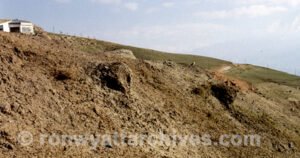
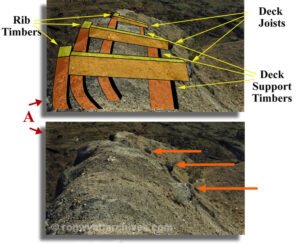
He showed us deck support timbers that were protruding from the earth- timbers that had once held up the decks much like the poles in a basement hold up the floor of the house.
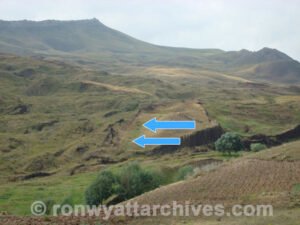
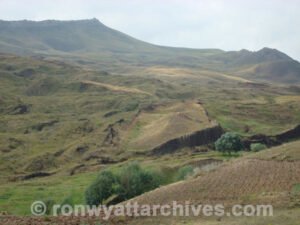
He took us around to the sides and showed us where the 1960 team had blown several holes in it with dynamite, and from which he had obtained numerous specimens of petrified wood.
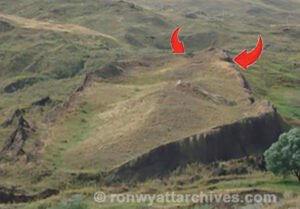
Rifles Pointed in our Face
Next Ron wanted to take Nathan and I up the mountain to see the broken stele which had the pictographs of the ark with 8 faces and the ravens on it, with the crude outlines of the mountain ridge. As our taxi drove up, a whole gang of soldiers met us at the car, their rifles pointed in our direction. I realized Ron had been telling the truth about it being dangerous. Then, Dilaver, the taxi driver and Ron's long-time friend, smoothed things over and we soon found ourselves inside the crude military building having terribly strong tea.
The soldiers presented me with a macrame necklace they had made which had a bullet hanging from the intricate pattern of the thread which reminded me of thick dental floss. It was raining a bit and we stood outside in the drizzle, just staring down the mountain. The ark was down the mountain, hidden by the rugged hills while off in the distance we could see the structure which had incorporated in it the broken pieces of the stele. And we weren't allowed near it. It was being used as a boundary marker for the no-man’s land between Turkey and Iran. and apparently there were more than one marker made of the broken pieces of the stele.
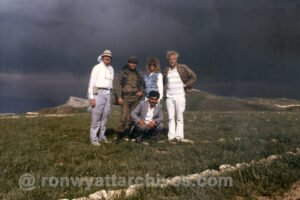
Drogue Stones from Noah's Ark
Ron explained to us about the drogue stones, which he had once called anchor stones. He realized they were not used as anchors but he believed they were used on the ark for stability. Placed on the rear of the ship, their drag would hold the nose of the ship into the massive waves, preventing it from turning sideways where the waves could completely roll it over. Placed on the sides of the ship, they would stabilize the ship, helping it remain on an even keel instead of tilting sideways.
VIDEO- Ron explains the purpose of the drogue stones:
The Locations of the Drogue Stones
There was also something else about the drogue stones that was particularly fascinating. The ones Ron and his sons had found in 1977 were perhaps 20 miles from where the remains of the ark now rested. In the village where these first ones were found, there were 2 large hills, side by side, a little west of it. On the tops of each hill, Ron found a drogue stone. Then they were scattered past this point in the direction of the final resting place in the mountains of Ararat.
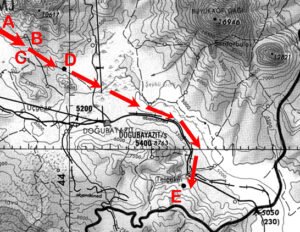
On the above map:
A is the location of a drogue stone Ron had only found in 1987 or 88- I'm not sure of the exact date. It is about 5 miles west of the village.
B and C are the locations of the two most western drogue stones, each on the side of a hill next to each other. Ron believed the ark drifted between the two hill and drogues became tethered on each hill and were cut loose.
D is the location of the village Arzap, also known as the 'place of eight".
E is the location of the ark today.
This map shows that the ark drifted from west to east through the Ararat Plain then drifted south into the cretaceous mountains of Ararat. The volcanic Mt. Ararat is north of the ark about 15 or so miles.
Drogue Stones Could Also Determine Depth
He concluded that in addition to providing stability, the stones were on ropes of varying lengths. As the water receded, he surmised that someone on the ark cut them loose as they would settle on the earth beneath the water. This allowed the stalled ship to continue floating until the waters fully receded from the earth. Depending on the length of the rope attached to each one, Noah could tell how deep the water was as they snagged on the ground under the water.
The account in Genesis speaks of quite a long time in which the ark was drifting in the area before the tops of the mountains were seen:
Gen 8:1 And God remembered Noah, and every living thing, and all the cattle that was with him in the ark: and God made a wind to pass over the earth, and the waters asswaged; 2 The fountains also of the deep and the windows of heaven were stopped, and the rain from heaven was restrained; 3 And the waters returned from off the earth continually: and after the end of the hundred and fifty days the waters were abated. 4 And the ark rested in the seventh month, on the seventeenth day of the month, upon the mountains of Ararat. 5 And the waters decreased continually until the tenth month: in the tenth month, on the first day of the month, were the tops of the mountains seen. 6 And it came to pass at the end of forty days, that Noah opened the window of the ark which he had made:
The Covering of the Ark?
Traveling east from the village towards the ark, Ron found several more. He also found a most fascinating large, petrified object that looked just like tree bark. This, Ron believed, was possibly part of the covering that Noah threw off the ship when he opened the window spoken on in Genesis 8:6. Nothing is more waterproof than bark even today.
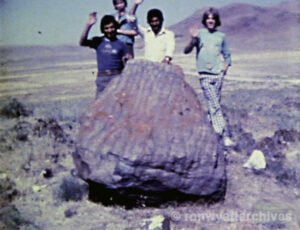
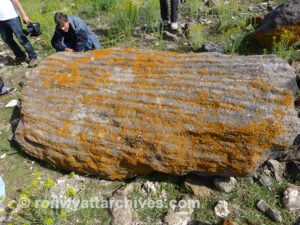
In addition, in the village were numerous large pieces of petrified wood which could also have been part of the covering of the ark that Noah removed. There really isn't any other explanation for these massive pieces of petrified wood.
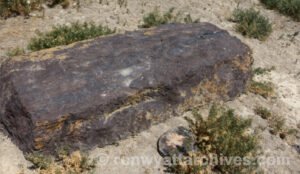
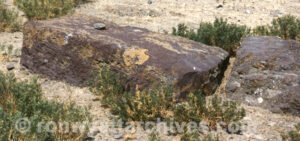
We saw a number of these and some were still mostly covered by the soil. This indicated to Ron that they were only recently found by the villagers. None of them had any crosses carved on them. They disappeared from the village many years ago and no one seems to know where they are today.
Ultraviolet Painting on the Drogue Stones
Before the trip, Ron had enlisted me in helping him with an experiment he wanted to perform on the drogue stones. An "Ararat Report" article had claimed that an "Armenian specialist" who stated that the drogue stones were actually made by the Armenians as pagan objects, claimed that when the Armenians converted to Christianity, they chiseled away the original inscriptions and replaced them with Christian crosses. Ron wanted to test that theory.
He had learned about a procedure Egyptologists used in determining if earlier inscriptions had been removed from monuments and others chiseled on top of them. This involved painting the surface with an invisible liquid that is only visible in ultraviolet light. After a length of time, this liquid seeps into the tiny cracks and crevasses which are not visible to the naked eye but which can be seen with the ultraviolet light.
My brother-in-law works in research and development for Kodak in Rochester, NY so I called him. He referred me to a certain department at Kodak where I explained what we wanted to do. They sent me information on the procedure. We were able to find the liquid and a portable ultraviolet light.
Three young travelers from Australia that we had met in a Cairo ticket office joined us the next day after we had tea with the soldiers and with the help of everyone, we painted the crosses on the drogue stone that is standing in the village during the day, as well as a couple of other objects with crosses.
We had done a practice run on a headstone in a private cemetery just outside of Nashville and knew we needed to wait several hours before observing the results. We returned that night with the ultraviolet light and none of us could see any evidence of any earlier inscriptions. Everything was clean with no small cracks. And the villagers were quite fascinated with the whole thing. Unfortunately we couldn't video the results as our camera simply couldn't "see" in the extremely low light.
The Crosses on the Drogue Stones and Other Items in the Village
The original inhabitants of this region were Armenians who became Christians early as the message of Jesus Christ was preached far and wide. As mentioned before, the inhabitants of this region were massacred in about 1916-1917 by the Ottomans and new peoples came in and took over the land. They did not know the history of the region at all.
The evidence of the crosses is really all we have to go by, and that evidence speaks loudly of the early people identifying these objects- the drogue stones and the fossilized "bark"- with 8 people. The division of the crosses into 1 largest, one a little smaller, then 3 a little smaller yet, and 3 even smaller- fits distinctly with Noah (largest), his wife (2nd largest), his 3 sons (3 smaller) and 3 even smaller representing Noah's 3 daughter-in-laws.
The style of the crosses were Byzantine and Crusader. Ron wrote the following when he got home from his 2nd trip in 1979:
"We revisited the stone sea anchors and noted a large accumulation of pottery fragments at the base and immediate vicinity of the cross-decorated relics. This pottery dated from as far back as the late third millennium for ward to the late Byzantine period. I see as one explanation that they were offertory containers presented to a sacred relic."
Evidence that the Drogues are Preflood
Coupled with the fact that Dr. John Baumgardner had checked one of the drogue stones (whose hole at the top had recently been broken by the locals) with magnification and found that they contained no microscopic fossils, it was safe to say that these were preflood stones. Rocks today have tiny fossils in them due to the upheaval of the flood remaking the surface of the earth. If, as some people have tried to explain these away, they were made after the flood, the rock would contain microscopic fossils.
VIDEO: Dr. Bill Shea discusses the importance of the drogue, or anchor stones:
A Very Fortuitous Discovery of Ballast Material
Back at the ark, with the Aussies with us, Ron told us about the ballast material and described what it looked like. He said for everyone to keep their eyes open in case they saw any. Before long, Nathan appeared with a very large "rock" and asked Ron if this was what he was talking about. And sure, enough, Ron's eyes nearly bugged out of their sockets. Yes! And it was a beauty! It was the best specimen Ron had seen yet for displaying the unique appearance that slag has.
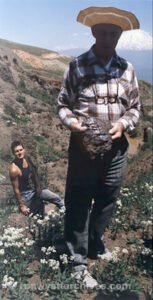
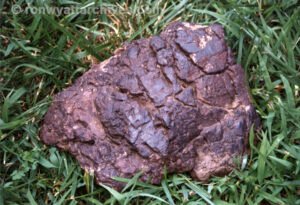
It was a wonderful trip and I could certainly see how Ron had become what some would call obsessed with the ark.
We were married on July 5, 1988 but my excitement was soon to become tempered with the frustration I would suffer when I learned the extent to which the personal persecution would go. Ron was used to it, but I'd never experienced anything like it. In fact, in my wildest dreams, I would have never believed that people who go by the name of Christian would or even could be so vicious. But I soon understood. They couldn't discredit the ark, so they were trying to discredit Ron.
Oct. 1988- A Drogue Stone is Unearthed Which Answered a Major Question
In October of 1988, Ron again returned to the site, this time without me but with Mark Yates, one of the Australians we had met who had signed on to work with Ron for a while. I still had a job and had already used my vacation so I couldn’t go. Mark had come to the US and stayed with us several weeks, helping us with some computer work and I was grateful Ron would not have to go alone.
Ron took some video releases for Dilaver and Hasan Ozer to sign for their appearance in the video documentary that was being made, which they signed. It was also at this time that Ron made an extremely important discovery, one that put an end to the "Armenian cult stone" theory about the drogue stones. Hasan Ozer showed him an anchor stone that had been buried in the earth, perhaps since the time of the flood itself, and which was now exposed due to soil erosion.
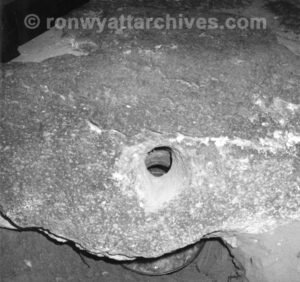
There were no crosses or inscriptions on this stone. Ron and Dr. Shea had supposed that since the crosses on the stones were Byzantine and Crusader style, and since the majority of them had 8 crosses, that these early Christians somehow had connected these stones to the 8 survivors of the flood. The newly exposed drogue stone was consistent with this conclusion. There were no crosses because it had been buried in the mud after the flood.
Ron would continue to travel to Turkey 2 to 3 times a year, sometimes accompanied by me, and sometimes not. By this time, there wasn't much left to do until the time that an excavation was possible. At least that is what he thought.
At one time, in 1987, he had worked with Ankara in preparing an excavation plan as well as the building of several hotels in the region. Ron had approached some people with a major airline in Memphis, Tennessee, who agreed to finance the project. And all seemed to be going along quite well. The architectural drawings for a covering for the remains were OK'd and it looked like nothing could stop it. But then came a financial reversal for the airline and all came to a dead halt. From this time on, the prospect of getting the funding needed to excavate seemed an impossibility.

Welcome to the Ron Wyatt Archives. I'm Mary Nell (Ron's wife) and this site will attempt to fully document Ron Wyatt's work and discoveries. This website will be an ongoing project to document his work on all his various discoveries. Please check back often as new things will be added constantly.
| READ MORE |

